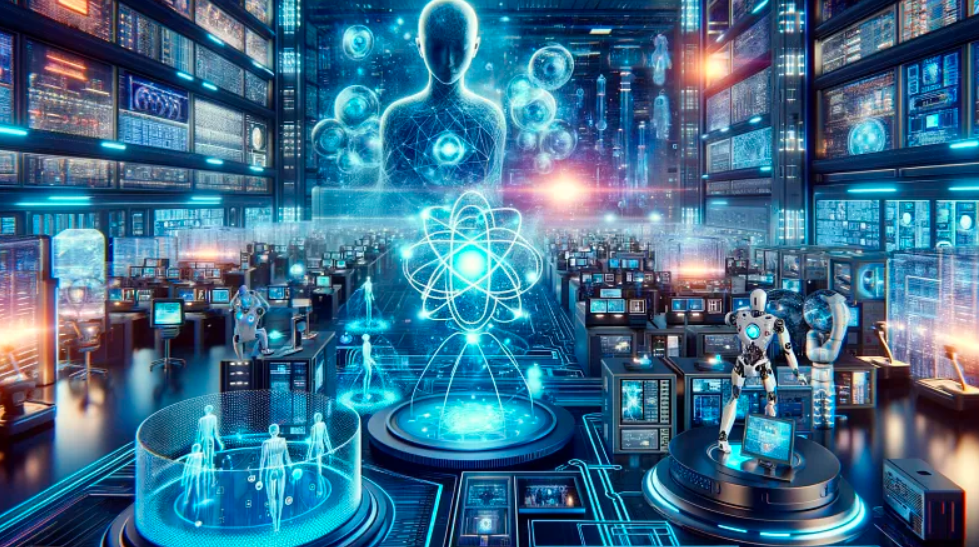In the 1970s, Lawrence Gasman explored potential PhD topics amidst a surge of interest in artificial intelligence. However, the lack of suitable processors hindered progress. It has taken fifty years for computing power to align with AI’s potential. Now, fueled by potent chips like Nvidia’s GPUs, generative artificial intelligence (gen AI) is transforming various aspects of human activity. From personalized content creation to enhanced voice recognition, gen AI is reshaping work, education, and entertainment.
Quantum computing introduces a paradigm shift in computing. Unlike traditional binary bits, quantum computing employs “qubits,” which can exist in multiple states simultaneously. This unique property exponentially increases computing power and allows for more nuanced simulations of natural processes.
While gen AI caters to consumer applications, quantum computing primarily targets industry needs, thus operating somewhat under the radar. Nevertheless, recent advancements in quantum computing hold the potential to accelerate the AI revolution.
Quantum computing excels in processing vast amounts of data, a fundamental requirement for AI applications. IBM’s Heron processor, featuring 133 qubits, showcases significant progress. Additionally, IBM’s Condor chip boasts an impressive 1,121 superconducting qubits arranged in a honeycomb pattern. These developments mark the transition into what IBM terms “quantum utility,” where quantum computing becomes a practical tool for various applications.
Different approaches to quantum computing, such as superconducting qubits and trapped-ion technology, offer unique advantages and challenges. IBM’s superconducting qubits leverage existing semiconductor technology but require cooling to near absolute zero. On the other hand, trapped-ion technology, as employed by Quantinuum, eliminates the need for cooling but presents scalability challenges.
The competition between these technologies underscores the complexity of quantum computing. Nonetheless, both approaches show promise in advancing AI capabilities.
The synergy between quantum computing and AI holds tremendous potential for innovation. The melding of these technologies could lead to groundbreaking advancements, driving the Fourth Industrial Revolution.
China has emerged as a leader in quantum research, with substantial investments in quantum computing infrastructure. Prof. Pan Jianwei’s Jiuzhang quantum computer demonstrates remarkable speed in processing AI-related algorithms, outperforming classical supercomputers by orders of magnitude.
Pan’s contributions to quantum communication further highlight China’s quantum prowess. The development of quantum technology has prompted significant investment from governments worldwide, including the United States.
However, the rapid development of quantum computing poses security challenges, particularly in cryptography. Quantum’s immense computing power could render existing encryption methods obsolete, necessitating new security measures.
Furthermore, the geopolitical rivalry between the U.S. and China extends to quantum computing. Both nations are investing heavily in quantum research, raising questions about the impact on global technological progress.
Despite these challenges, the potential benefits of quantum computing for AI are undeniable. As Google CEO Sundar Pichai notes, the integration of AI and quantum computing could unlock solutions to some of humanity’s most pressing challenges.
Yet, realizing this vision requires overcoming significant obstacles, including the shortage of skilled professionals in quantum computing. Addressing this talent gap is crucial for harnessing the full potential of quantum computing and advancing AI capabilities.
This article was originally published on time. Read the orignal article.
FAQs
- What is Gen AI, and how is it different from traditional AI? Gen AI refers to generative artificial intelligence, which has the ability to autonomously generate content such as articles, images, and music. Unlike traditional AI, which relies on pre-programmed algorithms, Gen AI can create content without explicit human intervention.
- How does quantum computing work? Quantum computing harnesses the principles of quantum mechanics to perform computations. Instead of using binary bits like traditional computers, quantum computers utilize qubits, which can exist in multiple states simultaneously. This enables quantum computers to process vast amounts of data and solve complex problems at unprecedented speeds.
- What are some potential applications of quantum computing? Quantum computing has the potential to revolutionize various industries, including cryptography, materials science, drug discovery, and optimization problems. It could enable researchers to develop new encryption methods, design novel materials with unique properties, and discover more effective drugs for treating diseases.
- What are the current challenges in quantum computing? Some of the challenges in quantum computing include maintaining quantum coherence, scaling up quantum systems, and minimizing errors in quantum calculations. Researchers are actively working to overcome these challenges to realize the full potential of quantum computing.
- How does the integration of quantum computing and Gen AI benefit society? The integration of quantum computing and Gen AI has the potential to unlock new opportunities for innovation and discovery. By combining the computational power of quantum computers with the creative capabilities of Gen AI, researchers can tackle complex problems more effectively and develop solutions that were previously unimaginable.
